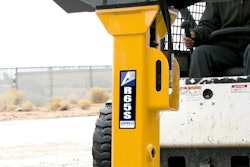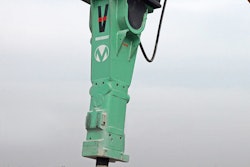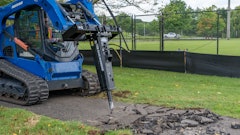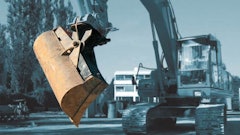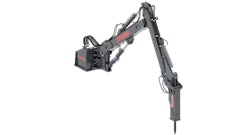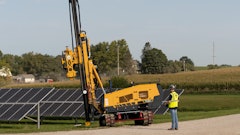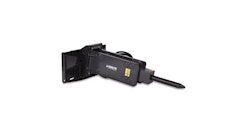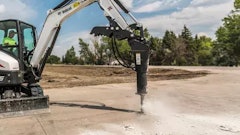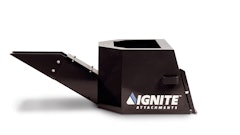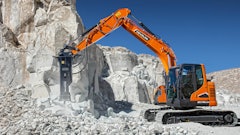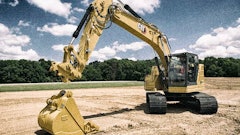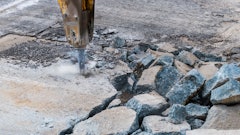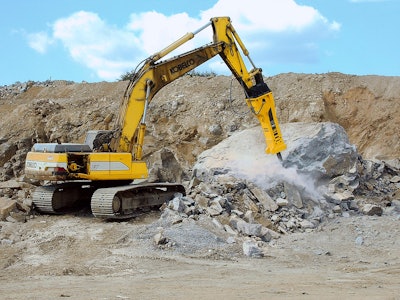
Designed to demolish rock, concrete and intact construction materials, hydraulic breakers can be a best friend on a jobsite where demolition is the end goal. Using proper operating techniques, pulverizing rock and breaking apart concrete can be accomplished efficiently and effectively. However, improper operation can just as easily derail a project, costing valuable time if a breaker fails unexpectedly on the job, or costing money by potentially increasing maintenance and/or shortening attachment life.
To ensure a long, productive life for your breakers, make sure operators are adequately trained and follow these recommended operating tips.
Don’t Dwell Too Long in One Place
In an attempt to finish a job quickly and break material all at once, some operators may start at the center of a rock or large piece of concrete. “But it’s better to work from an edge,” says Rob Sherwin, president, Arrowhead Rockdrill. “When you go straight to the center of the work, you can damage the working tool or wear it out prematurely. If it’s a rock breaking application, look for a natural crack to aid in the process.”
Hammering continuously in one place for more than 30 seconds is also counterproductive and can damage the breaker.
“Operators should follow the 30-second rule,” advises Matt Franzel, product manager, hydraulic attachments, Atlas Copco. “If the breaker is working in one spot for more than 30 seconds and the operator doesn’t see penetration, cracks, dust or fissures, they should stop and reposition the carrier to be closer to the edge of the material to be broken, or use a larger breaker. This prevents the tool from overheating, which can prematurely wear tool steel, damage bushings and ruin hydraulic seals.”
Greg Smith, marketing communications manager, Allied Construction Products, LLC, recommends running the breaker in one spot for up to 15 seconds. “If the material hasn’t been broken or penetrated, it’s time to try another spot,” he says.
Hammering in one spot too long is not only ineffective, it can generate an excessive amount of heat in the breaker and the carrier. “That can damage the carrier’s hydraulic system and will cause premature wear and failure to the breaker’s demolition tool, bushings and other components,” notes Smith.
It can also cause the breaker point to “mushroom,” or burr up at the edges, says Sherwin. “The impact energy is not allowed to break the rock or concrete as effectively as it rebounds back through the breaker, which could potentially cause machine issues,” he explains.
Minimize/eliminate Blank Firing
A certain amount of blank, or dry, firing is inevitable given the nature of the task at hand. But it can be hard on the attachment.
“Dry firing is one of the most damaging things that can happen to a breaker,” says Franzel. “It occurs when the tool steel isn’t pressed down against the working surface before the operator engages the hammer. The piston, which hits the tool steel, delivers 100% of its energy at the end of each stroke, without having anything to impede it.”
Ensuring there is enough downpressure (weight) on the breaker, while keeping it relatively straight up and down, can minimize excessive blank firing. “If you aren’t applying enough downpressure, you will see the breaker bounce around,” says Stephane Giroudon, general manager, Montabert, US. “That can damage the suspension inside the breaker and/or damage the boom.”
Sufficient weight must be applied in order for the attachment to function, allow the demolition tool to penetrate through the material and avoid blank firing, notes Smith. “When positioning the breaker, the operator should put downpressure on the breaker until he just begins to lift the tracks of the excavator off the ground,” he advises.
Knowing when to engage the hydraulics can also keep dry firing to a minimum, helping to lengthen the life of the pistons and other critical components. “Anytime you lift the breaker off the surface you want to break, disengage the hydraulics,” says Ron Peters, product manager, CEAttachments, Inc.
Match to the Carrier and Application
To ensure a proper match between carrier and attachment, manufacturers offer specification charts. Make sure to reference these charts before making a final selection.
“When a breaker is sized properly to the carrier, energy transmits to the work surface to effectively break material,” explains Franzel. “However, if a breaker is too large for the carrier, energy is instead transmitted in two directions: to the work surface and the machine. This diminishes the impact power on the material, which means it takes more hits to effectively break the material, and it can damage the carrier’s boom and hydraulic system.” The result is diminished impact power and productivity.
“On the other hand, using a breaker that is too small puts excessive force on the mounting components and working steel of the breaker, which can cause damage and lead to costly downtime,” says Franzel.
Work with your equipment supplier to ensure the breaker matches the carrier’s service weight and hydraulic output, as well as the application.
“If the breaker doesn’t have enough power to effectively break the material, the working steel and hydraulics can overheat and become damaged, again leading to costly downtime and reducing efficiency,” says Franzel. “It’s also a good idea to write the carrier’s model number near the breaker’s mounting bracket so an operator won’t inadvertently try to attach it to a different carrier.”
Also match the working point to the application. “There are several options available, ranging from moil points to chisel points to asphalt cutters. Make sure to match them to the proper application,” says Peters.
Don’t Pry
It can be tempting to move debris with the breaker to try to speed up the task at hand. “However, prying with the working point can break, bend or damage the tool,” says Peters.
Prying can also permanently misalign the tool steel in the bushing area. “When that happens, the hammer inside cannot make solid contact with the tool steel, which results in less productivity and additional downtime to get the unit repaired,” says Franzel.
Additional bad habits, such as using the breaker to carry equipment or trying to turn over a large boulder, can also damage the attachment. “Always ensure the operator is properly trained on the equipment and attachment before using it,” Franzel emphasizes.
Conduct Routine Maintenance
Daily maintenance should include a visual inspection of the breaker before use. “Check hoses as well as the breaker point, or working steel,” says Peters. “Also check the nitrogen pressure at least once a year. If it gets too low, it might not fire properly or it might not hit as hard.”
Daily greasing is also critical to optimal breaker function. “It’s important to have a regimented lubrication [program] in place to ensure the working surfaces of the breaker tool, the ground-engaging components and the guide bushings inside the unit are all well lubricated,” says Sherwin. “Proper lubrication also minimizes the ingress of dirt and dust inside the breaker itself, offering a two-fold benefit.”
“Proper greasing minimizes the metal-on-metal friction between the tool steel and bushings, which can create enough heat to melt tool steel,” Franzel explains. “When operators see shiny slivers of metal on the tool steel, it’s a good indication to add more grease.”
Many large breakers have automatic lubrication systems that deliver a constant flow of grease and eliminate the need for manual application. “Lube systems can be mounted on the breaker cradle directly or a larger tank can also be added to the carrier,” says Giroudon. “Either system reduces maintenance, helps protect the breaker and can extend life.”
If manual greasing is required, follow manufacturer recommendations — typically, every hour or two of operation.
Also consider the type of grease you’re using. Franzel recommends molybdenum-based, or moly-based, chisel paste with grease to reduce wear. “The best type of paste contains particles of copper and graphite that roll up like ball bearings between the tool steel and bushings to prevent metal-on-metal contact, which minimizes wear on the breakers,” he says. “The paste is also more viscous than standard lubricants, which allows it to remain between the steel and bushings and provide better lubrication for longer periods than just using grease alone.”



